The two terms represent two highly professional technologies. We can only do a brief introduction.
(a) Analogue signals
(i) Characteristics of analogue signals
Signals are quantified informations. It can be sound, temperature, velocity, pressure or voltage etc. Analogue signals are those signals that goes with time it carries. It is continuous. The above examples are all analogue signals. In the category of electronics, analogue signals refer to voltages that vary continuously with time. Natural analogue signals like sounds of thunder or wind cannot be input directly to electronic devices. They must be artificially changed to analogue voltages by probes (探測器). For example, varying levels of sound can be picked up by a microphone and output as varying potentials (voltages) (Fig. 78).

(Fig.78) Amplitude of sound wave varies with time, a typical analogue signal
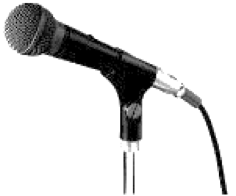
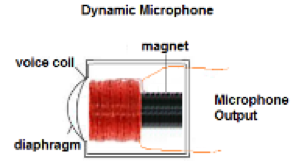
(Fig. 79) Moving coil microphone
Microphone had been invented for a long time. It is still a very important sensor probe in this era of digital electronic appliances. Microphone has many types and a common one is the moving coil type. Its structure is shown in (Fig. 79). Sound wave (longitudinal wave) causes the diaghram move to and fro, the voice coil connected to it does the same action. Since the coil is inserted into a magnet, this movement induces an e.m.f. Hence the coil outputs a weak analogue voltage signal.
Another item of similar working principle is a loudspeaker. However, it works the otherway round (Fig. 80), the diaphragm is made much bigger to send out amplified sound.
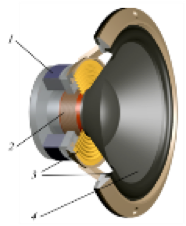
1. Magnet 2. Voice coil 3. Suspension material 4. Diaphragm (Fig. 80) Structure of a loudspeaker
Demo (1) Objects continuously vibrate send out analogue signals
Required material: A radio with a loudspeaker, DMM, oscilloscope.
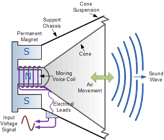
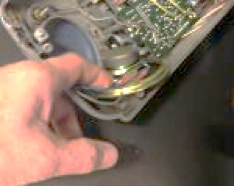
(Fig 81) Diaphragm of
loudspeaker vibrates
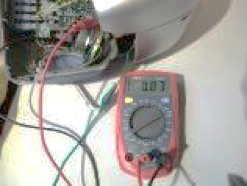
(Fig. 82) Radio outputs
analogue voltage
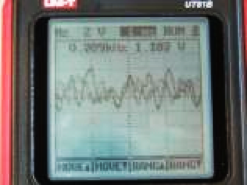
(Fig. 83) Oscilloscope registers analogue signals
Human ear can detect sound of frequency ranging from 20 Hz to 20,000 Hz.
Sound wave and range of detection
(ii) Storage of analogue signals
Although the technique of storing analogue signals is obsolete, nevertheless, it is still worthwhile to look back its development.
(a) Photography (storage of visual images)
Human eye receives reflected light from objects and sees them. Eye ball’s rectina receives focused light from the lens (inverted image), activates the complicated neurosystem of the brain and forms a holographic (全息的) 3D erected image with parallax (視差). Analogue photography works with similar principle. Camera and film (Fig. 84, 85) acts like the eye ball and rectina, but the developed negative film needs to be developed again to form positive photo (Fig. 86) The complicated neurosystem of the brain is completely bypassed, resulting in an image which registgers only wavelength, amplitude but no phase difference. Hence a photo is a 2D image without parallax.
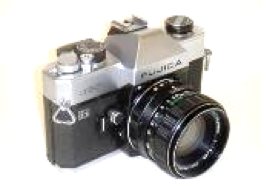
(Fig. 84) Film camera
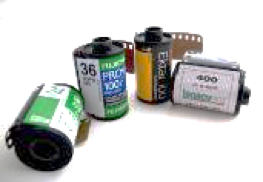
(Fig. 85) Film roll and film
(coated with light sensitive chemicals)

(Fig. 86) Photos for viewing and keeping
(b) Recorder of sound and video
Analogue signals consist of voltages changing over time, voltage and time appears as one. Varying amplitude of voltage goes with time, like shadow following a person. Analogue voltage can be stored. Amplitude of light is stored as photos or amplitude and time are stored as sound recorder or video recorder. Time can be artificially generated by motion. In the past, the most common method of generating time base is by rotation, time is generated by how long a recording disc takes to complete one turn. That is why decades ago all sound and video recorder involved rotating mechanisms. like record (Fig. 87), cassette tape (fig. 88) or VHS video tape (fig. 89). All-mechanical device like record has engraved grooves. When playing, rotating grooves cause the stylus to swing to and fro and generates weak induced analogue e.m.f. which is amplified by a HiFi audio amplifier to produce loud and pleasant sound. Unlike all-mechanical device, semi-mechanical device like cassette tape or VHS video tape use magnetic hysteresis technique involving rotating magnetic tapes to record or play back stored sound or video images.
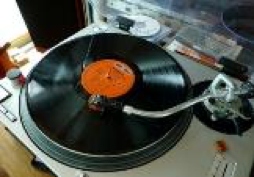
(Fig. 87) Record and turn table

(Fig. 88) Cassette tape

(Fig. 89) VHS video tape
(b) Digital signals
(i) Characteristics of digital signals
Processing digital signals is a great leap forward in the development of electronic technology, its far-reaching influence is compatable with the great industrial revolution. Most people think digital computation and its application is the hero of this great leap, but looking back more than 200 years ago we found Benjamin Franklin who discovered electricity should be the first hero. Electricity not only nutured digital revolution, it embraces the coming of post-iron age, i.e. modern age or nowadays. (Ponder advancement of technology and development of human history)
As opposed to analogue signals, digital signals and time can be or are not related. Digital signals are a huge number of processed binary (0 1) bits (位元, 比特) in the form of various combination of bytes (位元組,字節). Binary 1 bit takes the form of either (0). 0 V, or (1), 5 V, has to be either (0) state or (1) state, there is no other alternative. In other words, binary 1 bit is in fact an electronic ON/OFF switch. Binary 2 bit (0 1) can be (0 0), (0 1), (1 0) or (1 1). Binary 1 bit or binary 2 bit have no practical use in digital electronics. Binary 3 bit is also not included for computational purposes, although recently someone tried to relate 3 bit computation with Chinese ZHOUYI hexagram (周易卦象). You can refer to Wikipedia for more details. Binary 4 bit takes the form of (0 0 0 0), (0 0 0 1), (0 0 1 0), (0 0 1 1), (0 1 0 0), (0 1 0 1), (0 1 1 0), (0 1 1 1), (1 0 0 0), (1 0 0 1) … etc, 24 or 16 ways. A byte (位元組, 字節) contains 8 bits. Early models of computer used 16 bit CPU (Central Processing Unit) which could process 2 bytes, grouped as 1 word (字組). The popular 16-bit personal computer (PC), pioneered in 1990 by Microsoft Windows 3 (80386 CPU) was adopted worldwide. Nowadays, CPU of mainstream or personal computers are capable of processing 64 bit 4 words, each with a size of 2 byte 16 bit, e.g. Pentium of Intel Inc. and Athlon of AMD (Advanced Micro Devices Inc.).
Basically, a large number of discrete (x x x x) binary signals, where x is either 1 or 0 has no special meaning, unless they are organized in some form. This is exactly what software and hardware are aiming at. These bytes have to be assigned some common human meaning. The first generation of 8-bit computer, e.g. 1975 Motorola 6800 (Fig. 90), with 28 or 256 ways of assignment, assigned (0 1 1 0 0 0 0 0) to represent alphabet a, (0 1 0 0 0 0 0 0) symbol @. (0 0 1 1 0 0 0 1) numeral 1 etc, recognizable by a keyboard (ASCII coding, more details will be found in Topic 9.2). As such, software programs can be established by keying a keyboard. These assigned bytes then send to a computer, coupled with a time clock generating a precise 0V, 5V or (0 1) square wave signal chain for distributing them to various hardware compartments like motherboard’s various address and data buses linking the CPU and other peripherals for executing commands of a program.
All in all, digital signals, unlike analogue signals in which wavelength and amplitude are tied up with time, are discrete in nature in which (0 1) signals can be processed with time base or set aside unattended and stored. Also, analogue signals’ wave amplitude varies up and down, but digital signals have only two magnitudes, either 0V (0) or 5V (1). Processsing digital signals need hardware and soft ware. Hardware are parts that involve complicated electronic circuits that can decode programed (0 1) high and low voltages, i.e. a computer. Software (programs with commands) consists of complicated instructions enabling the hardware to operate. Actual situation is of course much much more complicated. Methods of creating and processing digital signals involve highly professional technology.
Digital and analogue signals are interconvertable
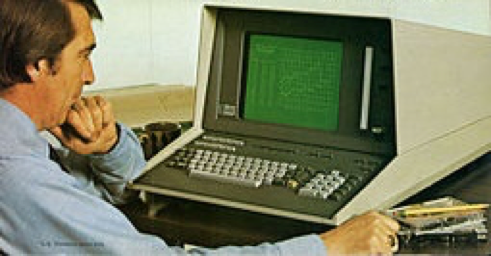
The Tektronix 4051 computing system used a 6800 microprocessor
(ii) Digital square wave and analogue sine wave interconversion
Demo (2) Converting sine wave signals to square wave signals
Required materials: 220V AC to 12V AC transformer, Op-Amp IC LM 358 (functioning as a comparator), breadboard, oscilloscope.

(Fig. 90) Low voltage tranformer
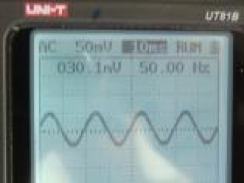
(Fig. 91) 30 mV 50Hz sine wave
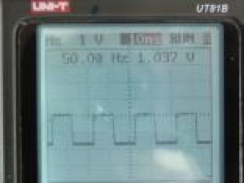
(Fig. 92) 1.04V 50Hz square wave
The city provides AC 220V power supply. Normal low voltage appliances should not use it directly. The first step is to convert 220V AC to low AC voltage, like 12 V AC。Circuit for comparator construction by an Op Amp IC can be completed on a breadboard (Details can be found in Topic 8.3.2d, page 92). A variable resistor voltage divider generates 30 mV low voltage sine wave (Fig. 91) which is fed to the differential (+) and (-) input of the Op Amp. Output of the IC delivers 1.04 V square wave signal (Fig. 92).
Project (1) Generate a diagram of converting a square wave signal to the corresponding sine wave signal
Assume: (i) Range of amplitude of sine wave signals is +5V/ -5V, and that of square wave signals are 0V / 5V
(ii) Comparator receives sine wave signals at the IC (+) and (-) input, outputs square wave signals.
(iii) 0V input / 0V output
(iv) Threshold voltage (Topic 9.1 has details) is ±5V and 0V
(v) Starts from 0V
According to (Fig. 93), both sine wave and square signals start at 0V. As the sine wave signal at the input proceed to -5V, the threshold voltage of the comparator is triggered and the output instantaneously jumps to +5V (Topic 8.3.2d). The output state holds at +5V, a functional feature of a comparator. When the sine wave signal proceeds further to 0V, the threshold is again triggered and the output falls to 0V and stays as it is while the sine wave signal heads towards +5V. When the sine wave signal reaches +5V, threshold triggering brings the output square wave signal back to +5V. The cycle repeats and repeats until a chain of square wave signal is formed.
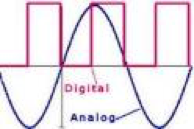
(Fig. 93) Analogue / digital signal interconversion
With reference to the interconversion method as shown Fig.93, try to convert the digital signal of Fig. 94 to the corresponding analogue sine wave signal. Try to complete Fig.95 by filling in the analogue signal. You can assume any magnitude of wave amplitude (Hint: consider periodic cycle).
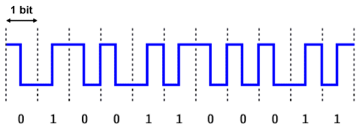
(Fig. 94) The high and low voltages of a digital signal chain

(Fig. 95) Complete the corresponding analogue signal
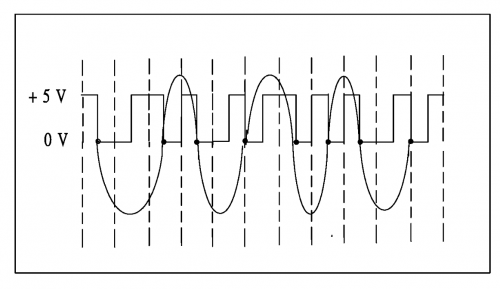
(Fig. 96) Answer
(iii) Analogue signal to digital signal and vice versa: analogue to digital converter, ADC and digital to analogue converter, DAC (模擬訊號轉為數字訊號,數字訊號轉為模擬訊號)
Practical interconversions in daily life are not dealing with simple sine waves or square waves. Practical analogue signals would not have stable wavelengths or amplitudes. Hence their corresponding digital signals take various forms as shown by the following diagram:
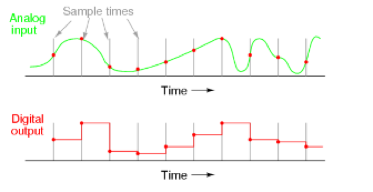
(Fig. 97) Practical interconversion (ADC) between analogue and digital signals
(iv) Storage of digital signals
There is only one way to store nature’s analogue signals. That is using human being’s very mysterious, complicated and still not yet solved mechanism of neurosystem to recall facts, emotion, ideas, objects etc. Non-natural way, or artificial method, to store analogue signals have been illustrated earlier. The tools used were records and cassette tapes for sound and video tapes for regenerating motional actions. They became obsolete though.
Amplitude, wavelength and propagation time of analogue signals travel through space as three in one, all three elements have to be considered at the same time during processing. Unlike analogue signals, amplitude (fixed at 5V), wavelength (depending on mode of processing) and propagation time of digital signals may or may not have any relationships. Computers accept and output only digital signals. Daily life analogue signals like sound or writing cannot be directly input to computers, they must first be processed by probes and sampling sensors called A/D converters, converted to corresponding digital signals and then either undergo suitable computation or storage.
(v) Modes of digital storage
(a) Volatile memory
A typical digital memory unit is a bistable multivibrator, or called as a Flip-Flop (Fig. 98). A workable flip-flop is a latch. The two states of the electronic circuit are stable, they will stay as it is, either 0 or 1 state, unless triggered. If triggered, it will junp from one state to another (Fig. 99). The memory will be lost if the power supply is switched off. Memory of this type is called volatile memory. The RAM (Random-Access Memory) card (Fig. 100) of a computer’s motherboard belongs to this type of memory.
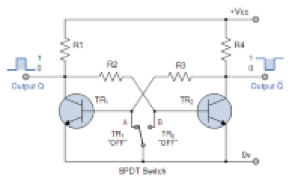
(Fig. 98) A basic flip-flop memory
Position of SPDT switch | Output | |
A | 1 | 0 |
B | 0 | 1 |
(Fig. 99) (0 1) state will change if triggered. Return to 0 if power is switched off
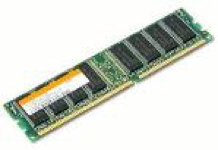
(Fig. 100) Computer RAM card
(b) Non-volatile memory
As its name implies, non-volatile memory retains the stored memory even if the power is switched off. The earliest type of this kind of memory is mechanical and not electronical. The prevailing punched card (Fig. 101) of 70s of last centry was a typical example. Later on, as the invention of using electromagnetic effect to write or read digital data on a fast-rotating disc had been developed, the commercial product was called a hard disk drive, HDD (Fig. 102 103). If the disc was engraved by a laser beam, it was called a Read-only-memory, CD ROM (Fig. 104). Both were mechanically-based (rotational motion) memory.

(Fig.101) Punched card code for FORTRAN
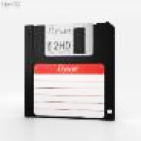
(Fig. 102) Obsolete 1.44 MB 3.5” floppy disk
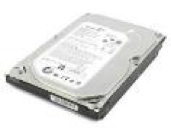
(Fig.103) 250GB 3.5” HDD

(Fig.104) CD ROM
Nowadays, non-mechanical electronic memory devices dominate the commercial digital accessories market. The mechanism of “flash memory” and its associated technology were used to manufacture various forms (MultiMedia Card, MMC, Memory Stick, MS, Secure Digital, SD, SIM Card etc) of high storage capacity non-volatile memory cards. Flash memory incorporates the use of floating-gate transistors to store digital data in a memory bit array cells, each bit stores either 0 or 1. Flash memory employs either the NAND gate flash technology or the NOR flash technology.
NAND-based storage commercial products deal with storing and retrieving digital data. It includes various forms of high storage capacity and fast read/write speed memory cards which consumes small amount of electricity to meet demands of smartphones, digital cameras or other portable appliances. Popular commercial models include USB (Fig.105) (Universal Serial Bus) “Finger” and SD (Secure Digital) cards. Extreme fast development of SD card results in available products like SDHC, SDXC, micro/mini SD cards (Fig.106), with high data transfer speed of 133 MHz and storage capacity of 2GB to 2TB. Today, most consumers prefer NAND flash SSD (Solid Stae Drive) (Fig. 107) to HDD for addressable memory.
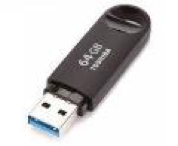
(Fig. 105) USB 3 “finger”
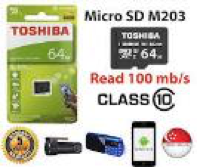
(Fig.106) 64 GB MicroSDXC
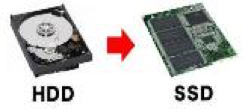
(Fig.107) HDD vs SSD
NOR flash memory is used for storing code and execution. It allows quick random access to any location in memory array. NOR flash memory with ultrafast reading speed and addressable capabilities are used mainly for motherboard’s BIOS (Basic Input-Output System) ROM chip. It performs hardware initialization during the booting process (power-on startup), and to provide runtime services for operating systems and programs.
Summary
| Analogue signal | Digital signal | |
| 1 | Generated by nature or artificially | Generated artificially |
| 2 | Amplitude, wavelength and propagation time need to be processed at the same time. | Discrete nature, amplitude (fixed) wavelength and time can be processed separately |
| 3 | Magnitude of amplitude is always changing. | Amplitude of signal is fixed at either 0V (0 state) or +5V (1 state). |
| 4 | Mechanical (rotational) electromagnetic way to store signals. | Mechanical or non-mechanical (more popular) way of storing data signals. |
| 5 | Not much room for further development of the technique of processing anlogue signals. Well-developed Linear Op Amp IC is still having a place in the electronic industry. However, the technique of processing analogue signals will never be eliminated. | Technique of processing digital signals is experiencing great leap forward. Infrastructure of Logic gate chips had developed from processing only 8 bit to nowadays’s 64 bit processor. Number of bit and byte processed are determined by the operating software and hardware. Miniaturization of data storage device is non-stop and storage byte capacity is experiencing exponential increase. |
(vi) Why change analogue signals to digital signals?
All analogue signals carry with it more or less some interference signals, or called as (noise) e.g. environmental signals. Noise and its analogue signals always go together as one. For example, sounds of wind when human voice is amplified in an open area. Sounds of wind and human voice are indiscriminately amplified together, this is technically called as “distortion”. To eliminate such unwanted noise, one way is to convert the analogue signals to digital signals through an ADC (Analogue to Digital Converter). The digitized noise signals then undergo a DSP (Digital Signal Processing) filtering network to obtain a clean digital signal which can be converted back to analogue signals by a DAC (Digital to Analogue Converter). Sound wave (voice) undergoing such process will have zero distortion and attain a high fidelity (Hi-Fi) sound quality.

(Fig 108) Reduced pixel of Marilyn Monore showing groups of tiny squares
A suitable connection between analogue signals and digital signals is to reduce the pixel (像素) of a digital photo. You will first find it (looks as if an analogue image) becomes blur, gradually forms a group of tiny squares (digital signals, pixel) (Fig. 108). In short, regrouping digital signals can form analogue signals and vice versa. Digital sampling of analogue signals results in binary byte data signals which can be processed by a computer. Only through this means can outside world’s analogue signals be input to a computer. The part playing this role is called an “interface”.
(vii) The mysterious human brain memory
Why and how can we remember? A simple question but very difficult indeed to give a full answer. We remember because we use our brain. How does a human brain really work? It is again another big big question. Not solved yet, albeit elucidating functions of regions of the brain. A rough schematic picture of ways in which our brain works, gathered from internet informations, can be viewed at two simultaneous levels:
(a) Functional-approach level: Category of this level include sensory memory, short-term memory and long-term memory, involving storage and recall procedures. Functional regions of the brain are somewhat like built-in software and recall of memory is a consequence of execution of such built-in software. However human memory, unlike computing software, incorporates the built-in dimension of time. Memory cannot be detached from the brain and feed in as required, as computer software do. We do not call our memory as version 1 or 2, instead it grows, develops, sustains, abates and finally disappears.
(b) Cellular-activation level: The main player is the neuron cells. A very crude analogy between neurological system of the brain and computation hardware hierarchy is the electronic logic gate architecture activated by digital pulse signals. However, conventional computation hardware, no matter how well miniaturized, cannot be directly interfaced into the human neurological system.
Recently, the idea of bio-computing technology received much attention. According to internet information, the major difference between conventional electronic computing technology and the developing bio-computing technology is that the former was built on silicon-based substrate hardware while the latter is expected to have an organic material (or carbon molecule-based) substrate “hardware”. Coupled with molecular logic gate (molecular switch) architecture and neuro pulse signal system, a bio-computer as such seems to be capable of integrating with human organs, with data transmission rate comparable with that of neurotransmission, offering an unprecedented breakthrough in medical science.
Neurological system of the brain involves far more complicated mechanisms other than cellular switch on/off propagation signals like digital bus communication. While electronic logic gate circuits are activated by linear or parallel electrical pulses, i.e. a 2-dimensional network, neurons of human brains are connected 3 dimensionally and activated by nerve pulses as well as chemicals such as serotonin and others. On top of these features, the dimension of time is also involved, making the inherited 4-dimensional infrastructure of human brain operates in a way far far more complicated than mere computational and inevitably be looked upon as a mysterious gift from a “creator”, as all started from the mere encounter of a sperm and an egg.
